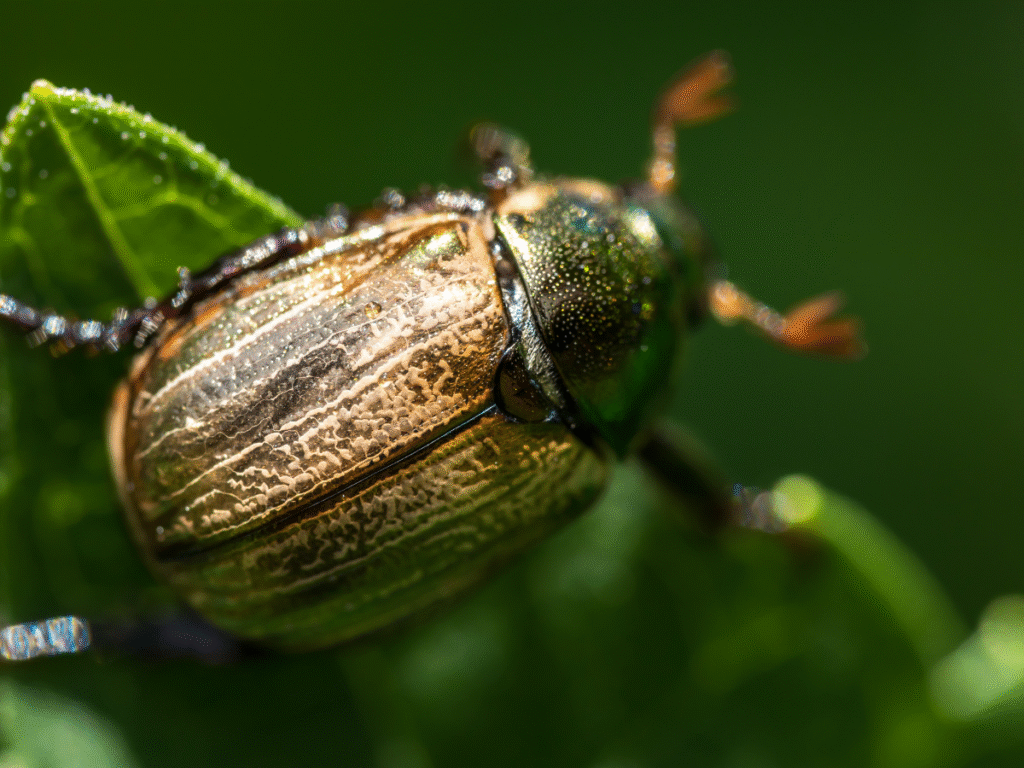What Are Japanese Beetles?
Japanese beetles are one of the most recognizable garden pests in North America. With their metallic green bodies and copper-colored wings, they may look striking, but their presence often means trouble for lawns, flowers, and crops.
These beetles are originally from Japan and were first found in the U.S. in the early 1900s. Since then, they have spread widely across the country, feeding on over 300 different plant species. Homeowners, gardeners, and farmers all deal with their damaging feeding habits each summer.

Where Do Japanese Beetles Live and Eat?
Japanese beetles are most active in warm, sunny areas during the summer months. As adults, they live above ground on plants, flowers, shrubs, and trees. This type of beetle tends to gather in large groups on sunny days and prefers plants that grow in open, well-lit areas.
When it comes to eating, adult Japanese beetles are not picky. They feed on over 300 plant species, including roses, grapes, basil, beans, apples, peaches, and birch trees. They chew the soft parts of leaves, leaving behind a lace-like skeleton, and will also damage blossoms and fruits.
Their larvae, called grubs, live below ground. Grubs feed on grassroots in lawns, golf courses, and pastures. This underground feeding causes brown, dying patches of turf that pull up easily from the soil.
So in short:
- Adults live on plants and eat leaves, flowers, and fruits.
- Grubs live underground and eat grassroots.
What Problems Do Japanese Beetles Cause?
Japanese beetles create problems both above and below the ground. Adult beetles feed on leaves, flowers, and fruits, often leaving plants with skeletonized foliage and damaged crops. This feeding weakens plants, stunts growth, and reduces harvest quality.
Their larvae, known as grubs, live in the soil and feed on grassroots. This can kill patches of lawn, cause the turf to brown and lift easily from the soil, and attract animals like skunks or raccoons that dig for grubs, creating even more damage to your yard.
How to Keep Japanese Beetles Off Basil
Basil is one of the plants Japanese beetles love the most, and if you’re growing it in your garden, you’ve probably seen how quickly they can strip the leaves. Luckily, there are a few simple steps you can take to protect your basil and keep it looking fresh through the summer.
- Hand-pick daily: Check plants early in the morning when beetles are sluggish.
- Neem oil sprays: Can deter feeding and reduce egg-laying.
- Row covers: Use lightweight fabric to shield basil plants, especially during peak beetle season (June–August).
- Companion planting: Some gardeners plant garlic or chives nearby to help repel beetles.
By combining a few of these techniques, you’ll give your basil a much better chance at surviving beetle season and staying healthy for your recipes.
Is There a Difference Between a June Bug and a Japanese Beetle?
Yes, June bugs and Japanese beetles are two different insects, even though people sometimes confuse them.
Japanese beetles are small, about half an inch long, with shiny, metallic green bodies and copper-colored wings. They are daytime feeders and love to gather in large groups on plants. You’ll usually see them chewing on leaves, flowers, and fruit in midsummer.
June bugs (often called May beetles) are larger, usually around an inch long, and have a plain brown, reddish-brown, or black shell. Unlike Japanese beetles, they’re most active at night and are famous for buzzing around porch lights. While their grubs can damage grass roots underground, adult June bugs don’t cause nearly as much plant damage as Japanese beetles.
Are Japanese Beetles Dangerous to Humans or Pets?
Japanese beetles might be a huge nuisance in the garden, but the good news is they aren’t dangerous to people or pets.
- To humans: Japanese beetles don’t bite or sting. The worst they’ll do is annoy you by swarming around plants or flying into you on a summer day. They aren’t poisonous or harmful if accidentally touched.
- To pets: Dogs and cats might eat a beetle or two while playing outside, but that usually doesn’t cause more than mild stomach upset. The beetles aren’t toxic, though eating a lot of them could irritate a pet’s digestive system.
The real problem with Japanese beetles isn’t health-related—it’s the damage they cause to plants and lawns. Their feeding habits can strip leaves, ruin flowers, and kill turfgrass, which is why they’re considered such a destructive pest.
Can You Permanently Get Rid of Japanese Beetles?
For severe infestations, professional pest control services are the best solution. At Alta Pest Control, our team is equipped with the knowledge, tools, and techniques to eliminate beetles and protect your home from future infestations.
Contact us today to help you get rid of your infestation!
